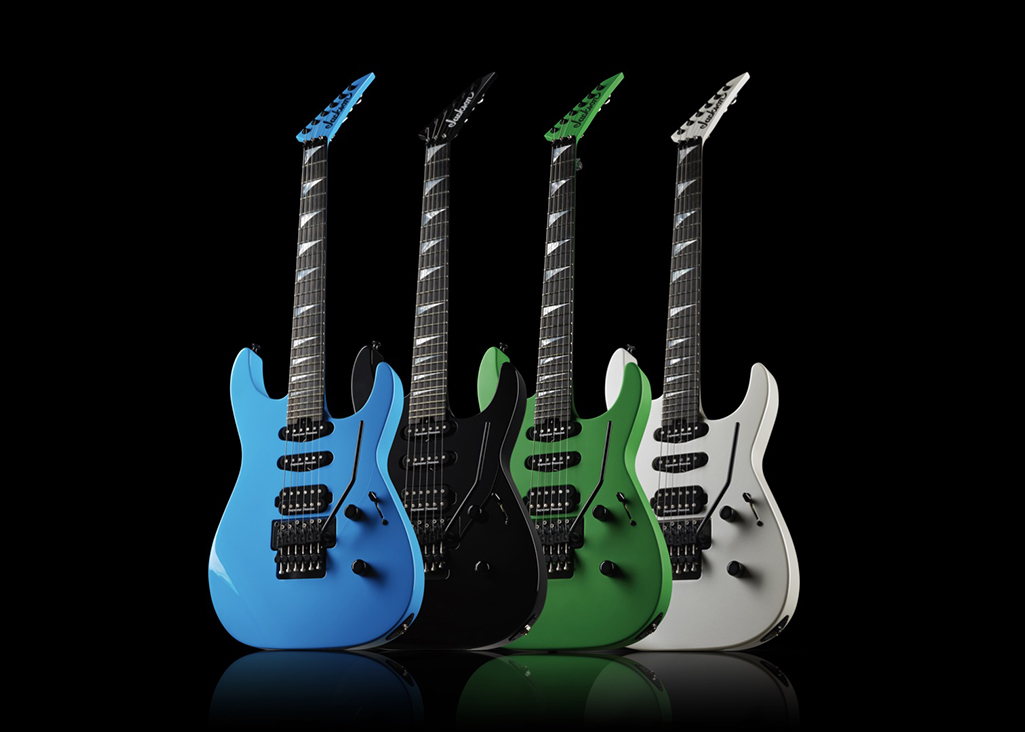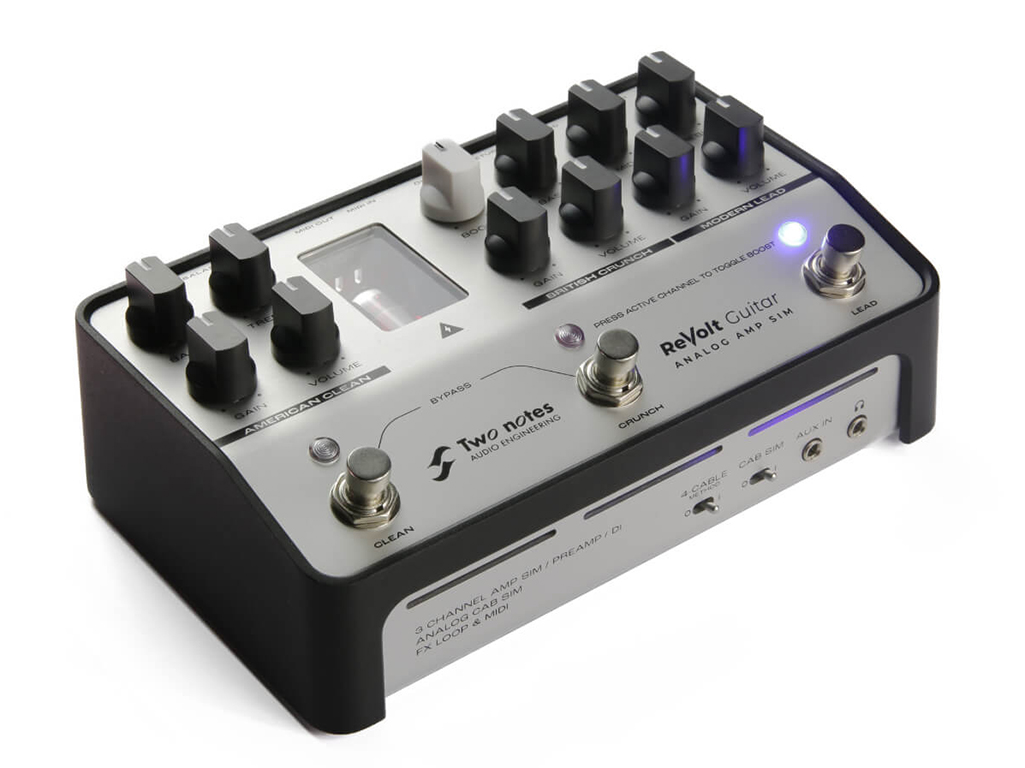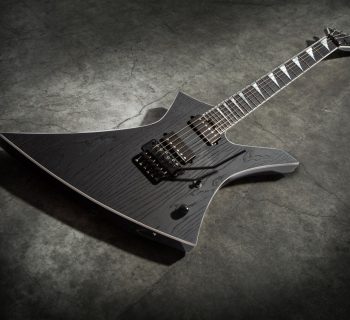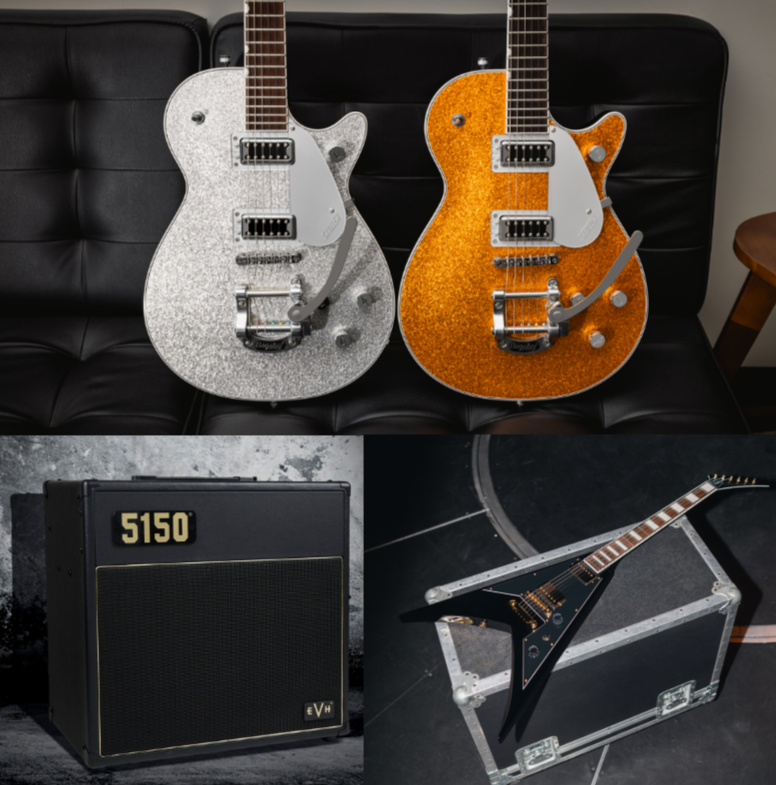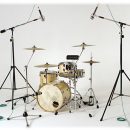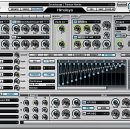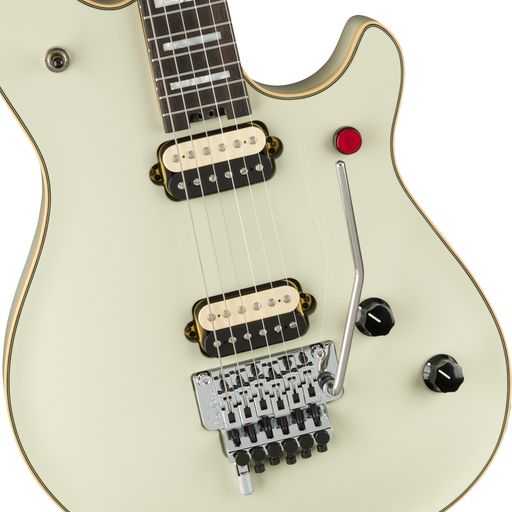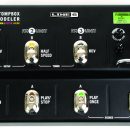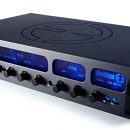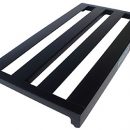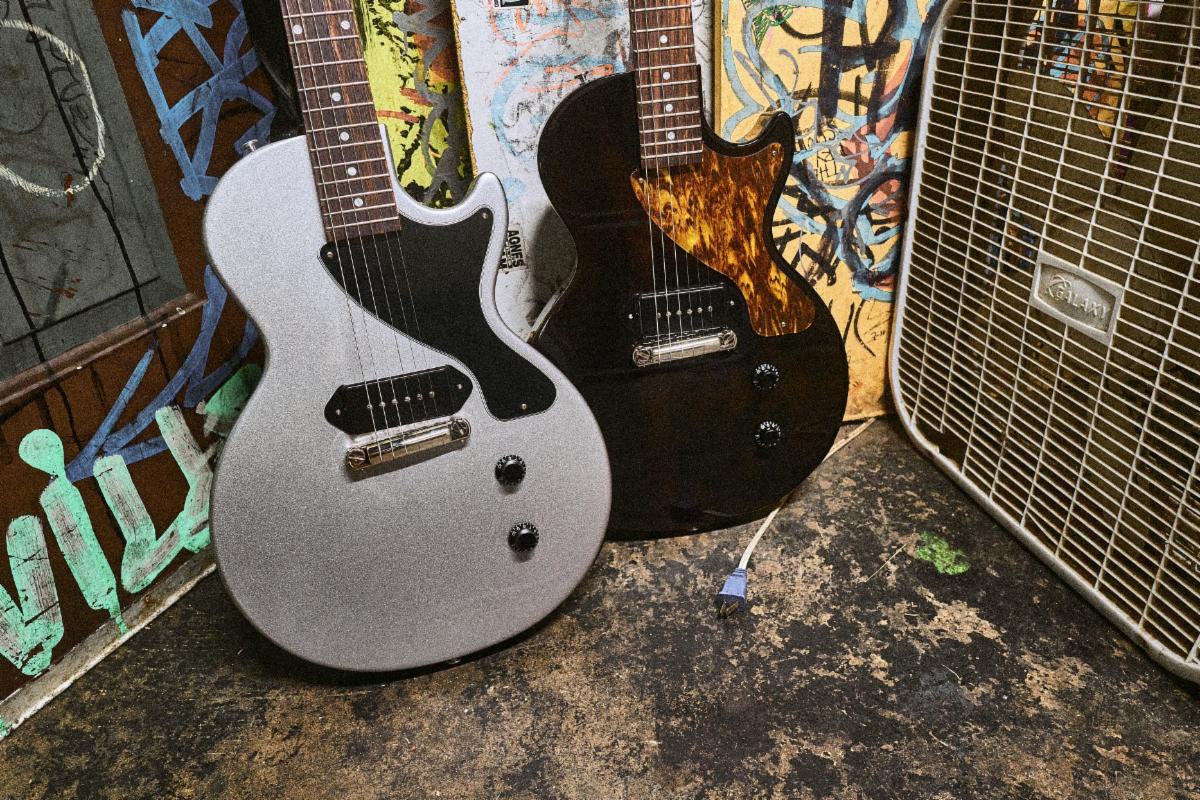Jackson guitars are well known to any rock player who was lucky enough to have witnessed the arms race of shred guitar development throughout the 1980s. When thinking of Jackson guitars, images of Randy Rhoads with his then-futuristic offset Jackson Flying V come to mind. The brand has been redefining itself ever since with a vast product line at every price point, typically built with the rock and metal player in mind.
The Jackson Soloist is arguably the centerpiece of the Jackson guitar lineup. It is an early superstrat design with many telltale appointments built to exacting quality, and this winning design has always made for an enjoyable, professional instrument. In short, when you saw a Soloist on stage, you knew the potential was there to get your face melted off by a shredding guitar player.

Today, the superstrat market is fiercely competitive and constantly evolving with each major (and some boutique) manufacturers attempt to reinvent the wheel and outdo what has already been done to death. Sometimes this works, but often it doesn’t. With so many superstrats on the market today, does the Jackson American Series Soloist remain a category leader?
Features
The Jackson Soloist SL3 shipped in a soft shell case and wore an impeccably finished gloss white paint job. The body material is alder, and it makes for a somewhat light guitar you can easily play longer than you can stand up. Your legs will tire before your back with this lightweight shredder.
 The SL3 has a HSS configuration selected via a typical five-way switch, one volume and one tone knob. The switching system is one of our favorite features on this guitar, as the pickups were specifically wound and selected for such a system. Position one presents the Seymour Duncan JB TB4 humbucker. Position two is the outer coil of the bridge pickup and the middle Seymour Duncan Flat Strat SLL6 RWRP single coil. Position three is the bridge pickup inner coil and the Seymour Duncan Flat Strat SLL6 in the neck position. Position four is the two single coils, and position five is the neck pickup alone. It’s important to note the only single coil alone is position five, and as such the only position that creates any extra noise in a high gain setup. This is well thought out and highly functional. The RWRP pickup in the middle position perfectly cancels hum when paired with either a bridge coil or the neck single coil.
The SL3 has a HSS configuration selected via a typical five-way switch, one volume and one tone knob. The switching system is one of our favorite features on this guitar, as the pickups were specifically wound and selected for such a system. Position one presents the Seymour Duncan JB TB4 humbucker. Position two is the outer coil of the bridge pickup and the middle Seymour Duncan Flat Strat SLL6 RWRP single coil. Position three is the bridge pickup inner coil and the Seymour Duncan Flat Strat SLL6 in the neck position. Position four is the two single coils, and position five is the neck pickup alone. It’s important to note the only single coil alone is position five, and as such the only position that creates any extra noise in a high gain setup. This is well thought out and highly functional. The RWRP pickup in the middle position perfectly cancels hum when paired with either a bridge coil or the neck single coil.
The SL3, unlike the Jackson custom shop SL1 counterpart, features a three-piece maple neck (as opposed to a quarter-sawn maple neck). Quarter-sawn maple is considerably harder and more expensive to produce, as well as creates more waste. Whether this was done as a cost cutting measure or a conservational one, we will likely never know. On a painted neck, what’s really the difference? The SL3 also noticeably does not include binding like the SL1, but instead features a rolled fretboard, which is a great design feature that many players prefer. With neck through-body construction, the neck features a 12-16” compound radius. A beautiful ebony fretboard with Jackson’s characteristic mother of pearl, shark fin inlays screams "metal." The guitar includes well-finished and highly polished nickel frets.
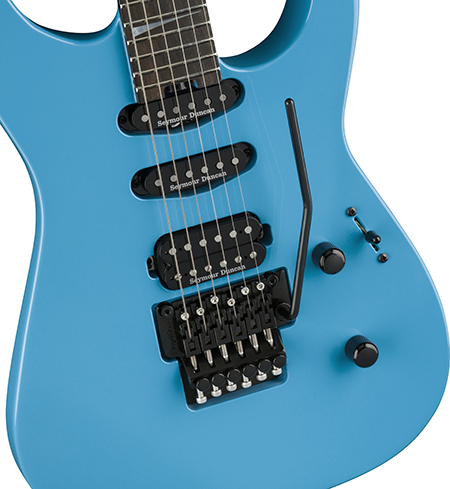 A Floyd Rose 1500-series, black, double locking tremolo keeps things locked down nicely with a little help from the Gotoh MTG locking tuners.
A Floyd Rose 1500-series, black, double locking tremolo keeps things locked down nicely with a little help from the Gotoh MTG locking tuners.
All in all, the feature set and design of the SL3 make for a modern take on a classic Superstrat. The only feature that bothered us a little more than it should have was the decision to exclude the phrase “MADE IN THE USA” in the typical headstock position under the Jackson logo. Instead, the back of the headstock denotes the guitar was made in Corona, CA. If you have been playing Jackson guitars as long as we have, this was the fastest way to separate the imports from the more sought-after American line. How much this seemingly minor aesthetic bothers you depends on factors well beyond the scope of this review.
Usability
We would like to start the Usability section by saying the compound radius is a pleasure to play. With a modern neck profile, there doesn’t seem to be a spot on the neck where the guitar feels uncomfortable, clumsy or cumbersome to play. Upper register access is effortless thanks to the guitar’s deep double-cutaway design. Coupled with the rolled fretboard edges and excellent fret job, the Jackson SL-3 is indeed a shredder’s dream to play. We also appreciated the rotary truss rod control access point at the base of the neck.
The Floyd Rose 1500 series tremolo bridge has faced quite a bit of contention, so we approached this fairly and with an open mind. We found the tremolo kept this guitar in tune, and the Gotoh locking tuners made string changes fast. Tuning stability was near perfect and has remained so for the few months we have had the test guitar. We definitely put this Floyd through its paces, too! The snap-in tremolo bar was also very stable, especially in comparison to something like a Lo-Pro Edge where when the nylon washers are new, it’s perfect, but once they get worn, the arm swings to the floor when you let it go.
The guitar weighs a little over 8 lbs. While this isn’t the lightest guitar we have reviewed or own, it’s definitely light enough to play on a multiple set night without starting to feel too heavy. This is something our aging staff becomes more and more sensitive to as years pass! 8 lbs. is right round the sweet spot for not feeling like a toy and not being too heavy.
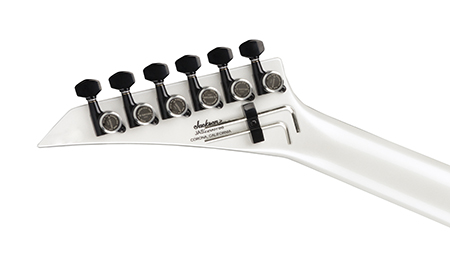 The pickup selector switch and wiring of the instrument was really the hidden feature we are surprised more people are not talking about. That’s why you’re here, though, to find out what’s so great about this easily overlooked detail. In short, the only way you can get a single coil tone from this guitar is in position five—for the neck pickup only. Every other position is some combination of single coils or the humbucker and single coil. This means you’ll only get some single-coil hum in position five. This was really well thought out for the modern rock and metal guitarist. Single coil pickups would typically be a “no go” in high gain situations, but the Jackson SL-3 makes intelligent use of them. Well done!
The pickup selector switch and wiring of the instrument was really the hidden feature we are surprised more people are not talking about. That’s why you’re here, though, to find out what’s so great about this easily overlooked detail. In short, the only way you can get a single coil tone from this guitar is in position five—for the neck pickup only. Every other position is some combination of single coils or the humbucker and single coil. This means you’ll only get some single-coil hum in position five. This was really well thought out for the modern rock and metal guitarist. Single coil pickups would typically be a “no go” in high gain situations, but the Jackson SL-3 makes intelligent use of them. Well done!
Sound
So you want to know about how the guitar sounds? If we were limited to only a headline, we would have to say “METAL AS F**K!” Thankfully, we have the bandwidth and time to give you a little more than that. Testing the guitar through our Fractal AxeFXIII, we pulled up a variety of amp models including an SLO-100 lead channel, a Dual Rectifier and a few Marshall amp models. We monitored through both a set of Adam A7 near field monitors in the studio as well as Slate VSX headphones. Finally, we had an opportunity to re-amp some test guitar tracks using our actual Soldano SLO-100 paired with the Two-Notes Wall of Sound plug-in.
This guitar begs to be played in its position one humbucker pickup, and most of our playing on this instrument stayed there. The JB pickup is hot, well balanced, and well suited for hard rock and metal playing without sounding too focused or tightly closed in. Position two has almost all of the power and punch of position one, but we hear more pick attack and articulation and a bit more openness in the tone. Position three sounds the most like a single coil spank, but pleasantly without the noise. This was also our favorite position for ethereal-like clean tones, too. The sound just really bloomed in a musical way in this position.
Position four actually fires this sound up a notch, giving the sound a bit more aggression and hair, while rolling off some treble just a little. Position five is your traditional neck pickup single coil with all its splendor (and noise). We honestly thought the guitar was broken when we heard all that hum in only that position. We became so trusting in pouring on the gain like it was a dual-humbucker guitar, we easily overlooked the fact that there are some single-coil pickups in this shredder. Needless to say, if you must have that creamy, neck pickup, woman tone, it’s there. Just be sure to use an appropriate sound in your amp for it.
Documentation and Product Support
Jackson maintains a robust website with extensive product information.
The instrument includes a two-year warranty. Jackson’s website Contact Us section only offers support via online message capture (a web form), but our contact to date with Jackson has been timely and thorough. They answered each of our questions.
Online, we found an all-products owners manual, which would serve to keep this guitar playing great, but we would have really liked a manual detailing this specific instrument.
Price
The Jackson Soloist SL-3 sells for $2,599.99. We feel this instrument hits the financial sweet spot for a domestic production instrument. It is by no means a cheap guitar, nor does it in any way feel like we wish we had a custom shop Soloist for a couple of thousand dollars more. Even if we did, we’d likely end up on a waiting list which as of this writing can be as distant as 18 months away.
Boutique custom shop competitors can cost as much as five to six thousand dollars for an instrument, so this is a bargain when compared in that circle. The Jackson SL-3 wins if you want a bit of early metal nostalgia with some modern features and want an American-made shred machine.
Contact Information
Jackson Guitars
www.jacksonguitars.com

